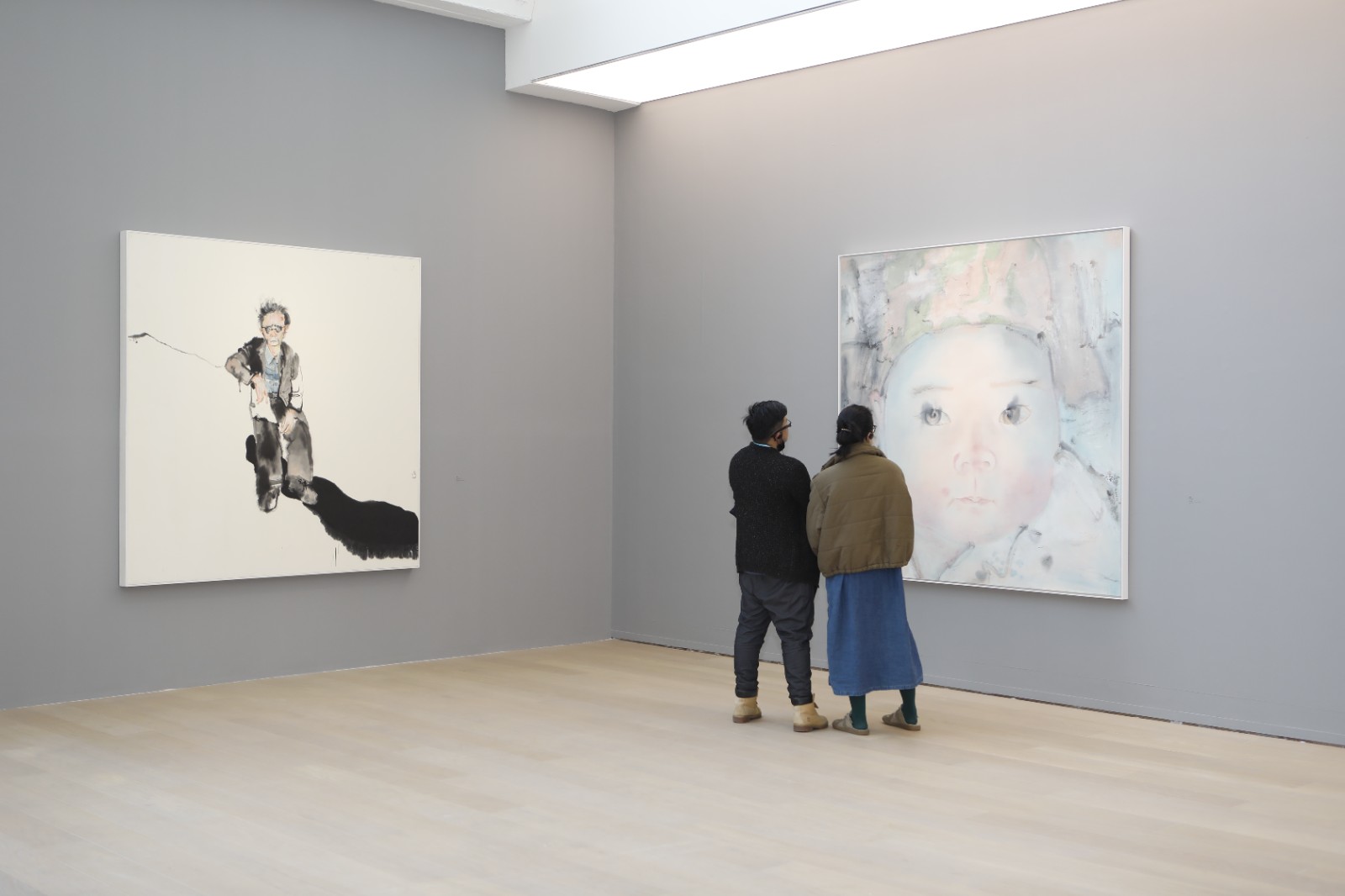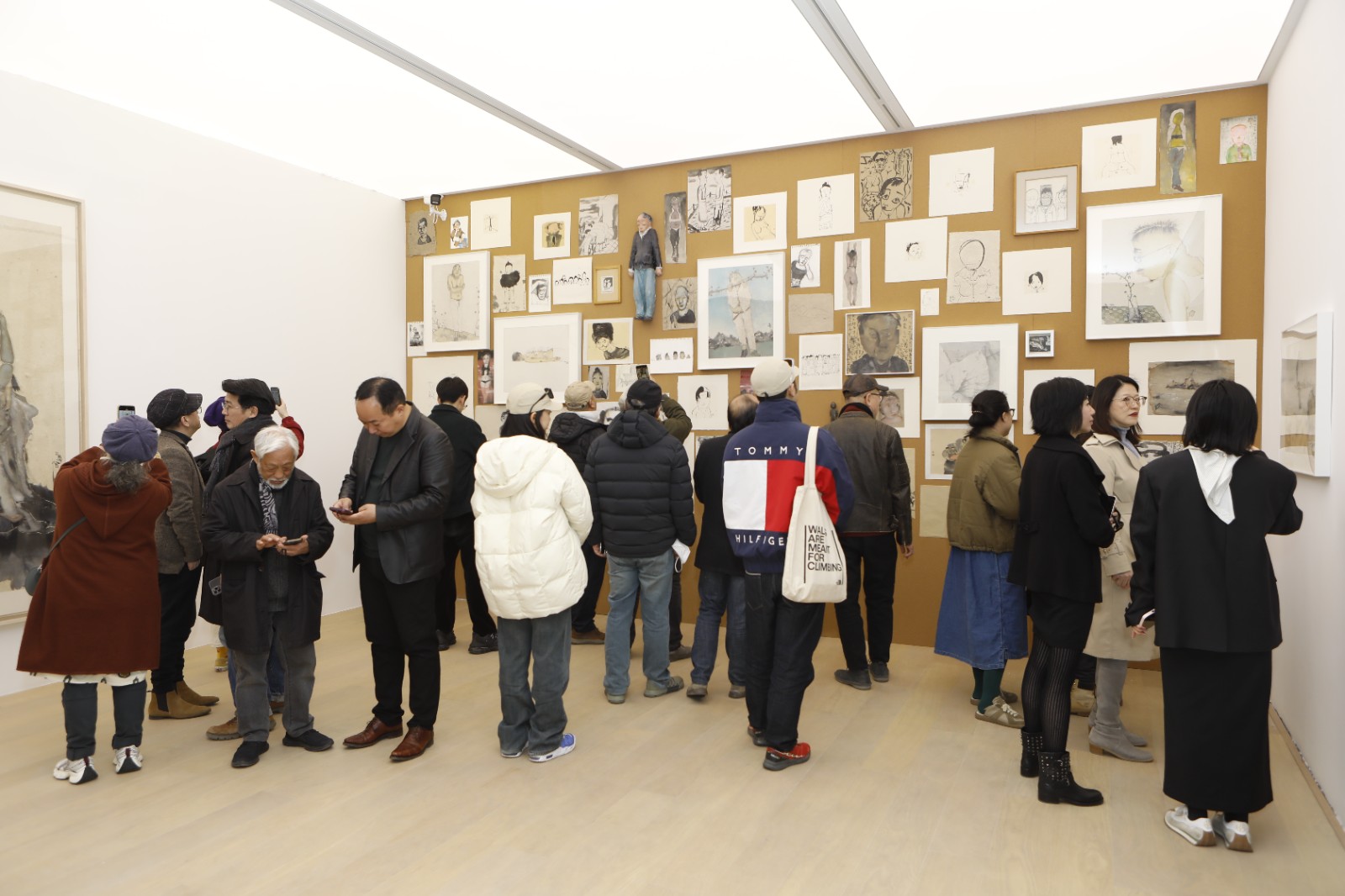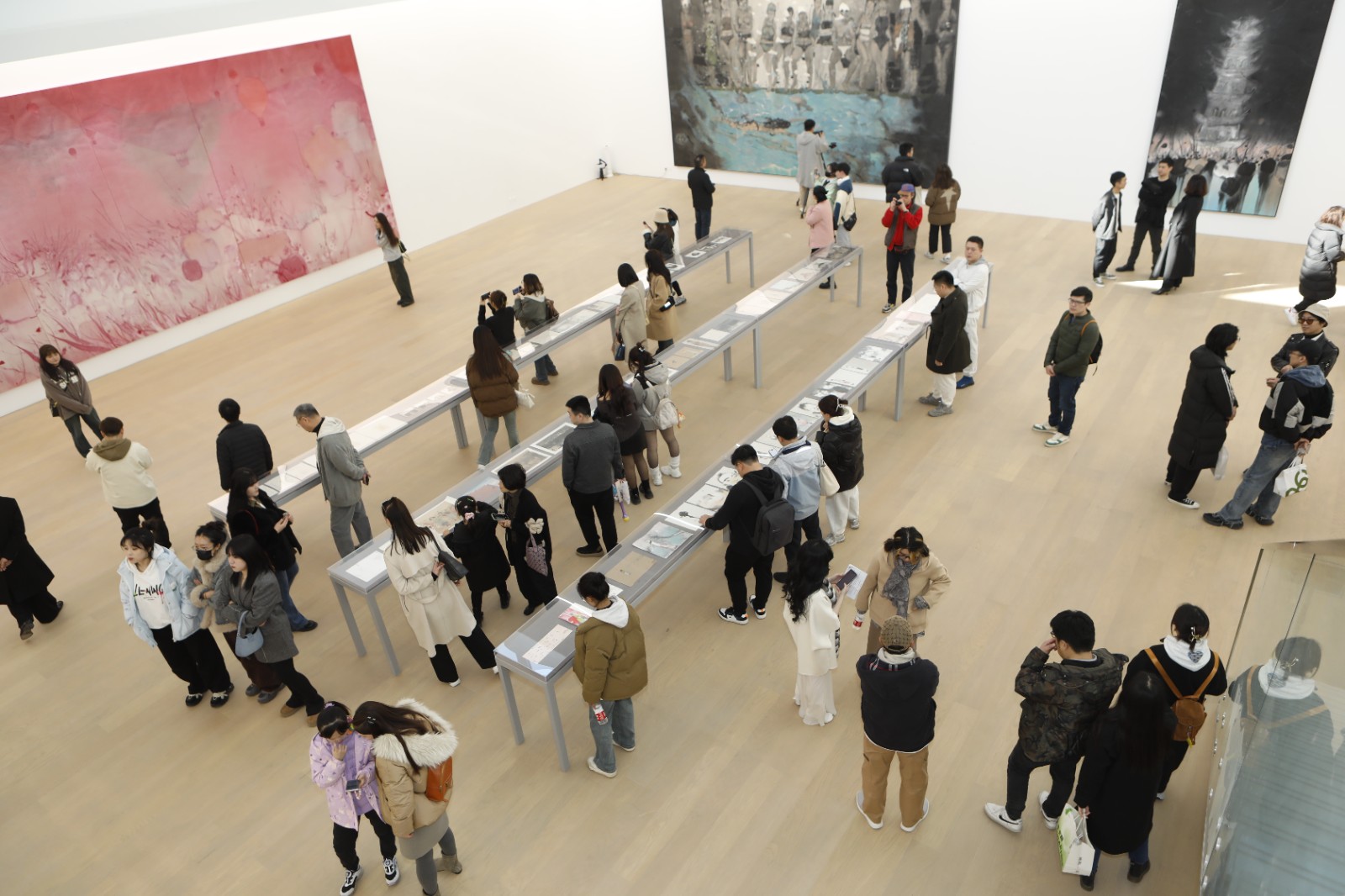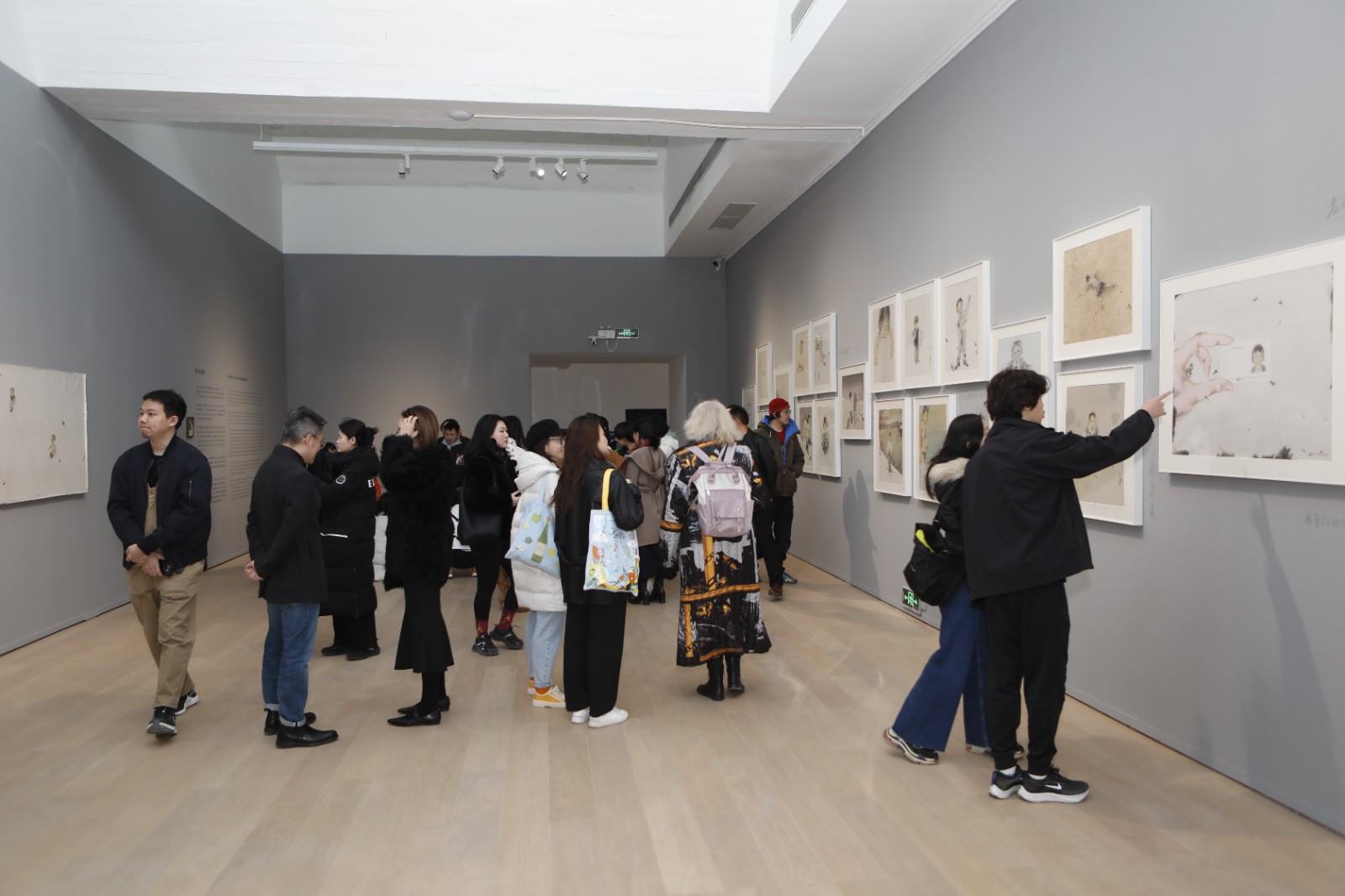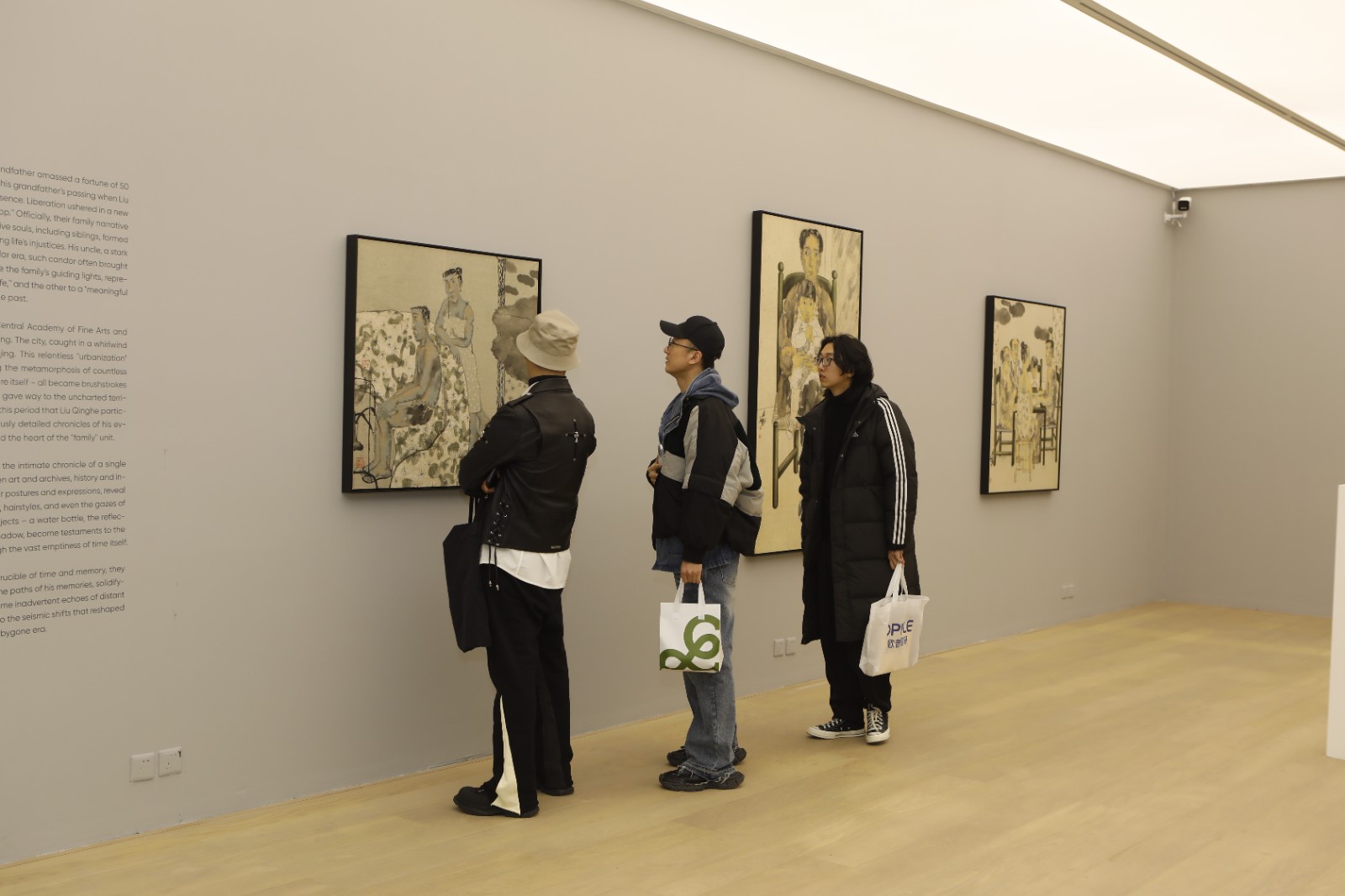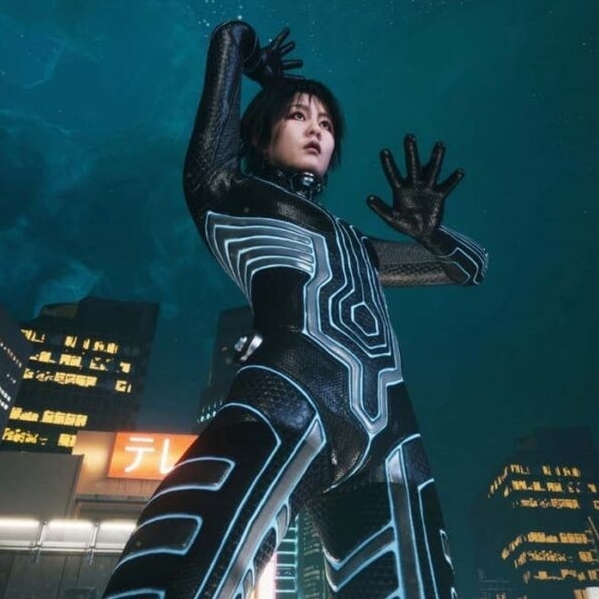View of the Exhibition Opening
Tang Contemporary Art presents Liu Qinghe's eponymous exhibition, the most comprehensive and detailed large-scale academic exhibition of Liu Qinghe's work to date, at the Beijing 1st and 2nd Space. Curated by Cui Cancan, the exhibition adopts a multi-linear narrative structure and is divided into seven parts, comprehensively organizing the artist's artistic development from 1979 to the present. The exhibition spans 45 years, with over 200 works on display.
Liu Qinghe, a preeminent figure in contemporary Chinese ink art, is renowned for his contributions to the groundbreaking "New Generation" exhibition and the innovative concept of "Urban Ink." This exhibition, however, transcends a mere recounting of past achievements. It embarks on a captivating exploration of Liu's artistic odyssey spanning over four decades, which is his relentless experimentation with artistic elements – grammar, themes, narratives, symbols, and metaphors – fueling his artistic evolution. Throughout his journey, his work has consistently resonated with and thrived within the ever-evolving landscape of contemporary art.
View of the Exhibition Opening
Unfolding across seven sections, the exhibition unveils Liu Qinghe's artistic journey. The opening section, "Monumental Ink Paintings and Manuscripts," lays the foundation with his signature polyphonic and multispatial narratives. We then shift focus to "Old Portraits of Two Families," where changes in era and theme showcase the artist's ability to narrate historical events through personal stories, embodying the concept of "small history." The exhibition takes a pivotal turn with Liu Qinghe's cross-media experimentation, highlighting his core pursuit of breaking boundaries and creating entirely new narratives using diverse media. Finally, the "Vernacular" series marks a bold departure from tradition. Here, Liu Qinghe embraces a completely new literary style, combining elements of diary entries, autobiography, and vernacular language, leaving behind the conventions of literati poetry, painting, and realism.
View of the Exhibition Opening
"New Urban, New Painting" marks a pivotal moment in Liu Qinghe's artistic journey. His groundbreaking works demonstrate the transformative potential of ink as a medium. In comparison to contemporaneous media, the unique sensations ink provides accurately capture the urban illusion, fundamentally touching upon the "era sentiment" specific to that time.
In over 40 years of artistic endeavors, Liu Qinghe has never rested on his laurels. "Temporal Estrangement" presents the artist's continuous self-renewal, a faithful representation of reality. Yet, he consistently employs new languages and methods to capture the ongoing occurrences in his surroundings. In the final section of the exhibition, works from different periods of Liu Qinghe's career to retrospect have been chosen, aiming to unveil the artist's worldview and philosophy concealed behind his creations.
Liu Qinghe's artistic journey reveals several defining characteristics. His groundbreaking "Urban" series fundamentally reshaped the language and concepts of contemporary art. He consistently pushes boundaries, exploring diverse mediums while maintaining ink painting as a vital force in contemporary practice. Through his "unique personal accent," Liu Qinghe constructs fresh narrative structures within his paintings, utilizing the vernacular. Underlying it all is a steadfast commitment to realism, evolving from symbolism to metaphor, and from the traditional literati artist to the modern individual.
View of the Exhibition Opening
Liu Qinghe's artistic odyssey, spanning over four decades, offers a valuable lesson. Throughout his career, he has consistently embraced transformation and open-mindedness, relentlessly pushing boundaries through experimentation. This relentless pursuit has seen him suspend the internal conflicts of ink, abandon the safe yet conventional territories, dare to make mistakes and pursue the avant-garde. In doing so, he dares to treat "ink" as a verb, a dynamic force for artistic exploration, rather than a static noun. This spirit of exploration, not just by Liu Qinghe but by his generation as a whole, has been instrumental in driving a remarkable cognitive shift in China over the past 40 years. The question has evolved from "What is ink?" to a far more transformative "What can ink be?"
This confirms a timeless truth: the embrace of "openness" and the relentless pursuit of the "avant-garde" are vital forces that propel us forward, regardless of the times.
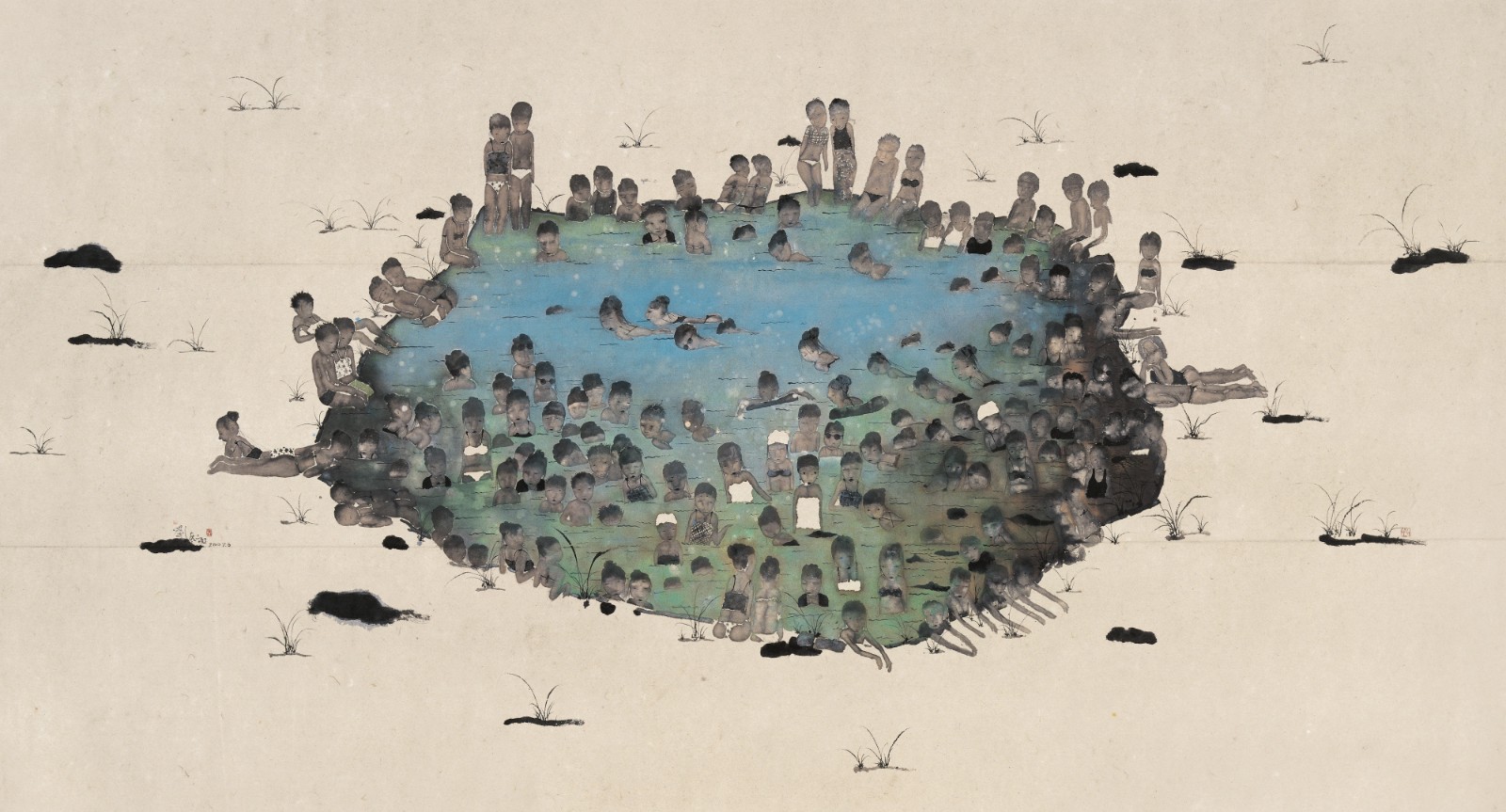
There is Fish, Ink and wash on paper, 270 × 500 cm, 2006
Monumental Ink Paintings and Manuscripts
In a departure from conventional methods, the exhibition refrains from retracing Liu Qinghe's artistic journey in either a linear or reverse chronological manner. Instead, it adopts a dual-narrative structure, introducing his most representative large-scale works since 2006 in contrast to manuscripts spanning over 40 years as the inaugural presentation.
Five monumental ink paintings, infused with Liu Qinghe's years of artistic exploration and vision, command the walls of the exhibition hall. Their staggering scale, mirroring the real world, transforms landscapes into breathtaking vistas of light and atmosphere. The paintings' immersive ambiance engulfs viewers, eliciting a powerful emotional response. In contrast to traditional ink works with their fragmented perspectives, these pieces employ a singular, modern viewpoint, unfolding a unified narrative for the viewer's exploration. The effect evokes the interwoven narratives, characters, and destinies of a full-length novel, a symphony of voices resonating within a single space. This becomes a hallmark of Liu Qinghe's large-scale works.

Island, Ink and wash on paper, 280 × 500 cm, 2013
Shifting perspectives also bring about changes in perception. Unlike the continuous narrative flow seen in traditional scroll paintings, these artworks provide a peeping experience. It's like standing on a high vantage point, catching a glimpse of an open lake through dense woods, adding a layer of encounter to the story, always evolving. Similarly, the "blank spaces" here become the blurred edges of the narrative, the hazy boundaries of the scene, creating a sense of distance for viewers. It's as if they and the figures in the painting exist in two different worlds, with the viewer's gaze serving as an intruder. Perhaps due to the bird's-eye view, these figures appear even smaller and more oppressed, like puppets in the hands of fate, conveying a sense of predestined helplessness.

Rosy Glow, Ink and wash on paper, 360 x 800 cm, 2024
In contrast to the scenic imagery found in traditional Chinese poetry, "Rosy Glow" possesses a grand emotional atmosphere of both realism and symbolism. However, amidst the interplay of light and shadow and drifting hot air balloons, it acquires an additional touch of dreamlike hues, resembling a movie set or a stage. Yet, the characters in the painting always seem lost and restless, their emotions indefinably fluctuating. In the vast space of these five monumental ink paintings, like scenes in a drama, Liu Qinghe reiterates the unique charm of painting in observing reality. It is neither entirely realistic nor completely subjective in its freehand expression; it is a virtual image of reality, a magical manipulation of time and space, an ambiguous perception that often feels closer to the essence of things than reality itself.
What shapes this unique visual experience and psychological mechanism? The central "Painter's Manuscripts" in the exhibition hall provides the answer, adopting the display format of traditional scrolls to starkly contrast with the contemporary feel of the monumental works. Nearly a hundred manuscripts, accumulated over time, unfold the path leading to these "magnum opuses": comic strips define Liu Qinghe's departure from the norm among ink artists, emphasizing the "shaping" of the plot itself and frequently employing "brush" and "lines," laying the groundwork for subsequent narrative emphasis; the sketch series allows us to glimpse the artist's initial emotions and how light, shadow, and form shape time and space; various manuscripts and sketches reveal the inspiration and conceptual origins of the initial stories, establishing the scenes; and the imitation series directs our gaze towards the artist's journey, the inherited resources, and the enduring influence of traditional Chinese painting.
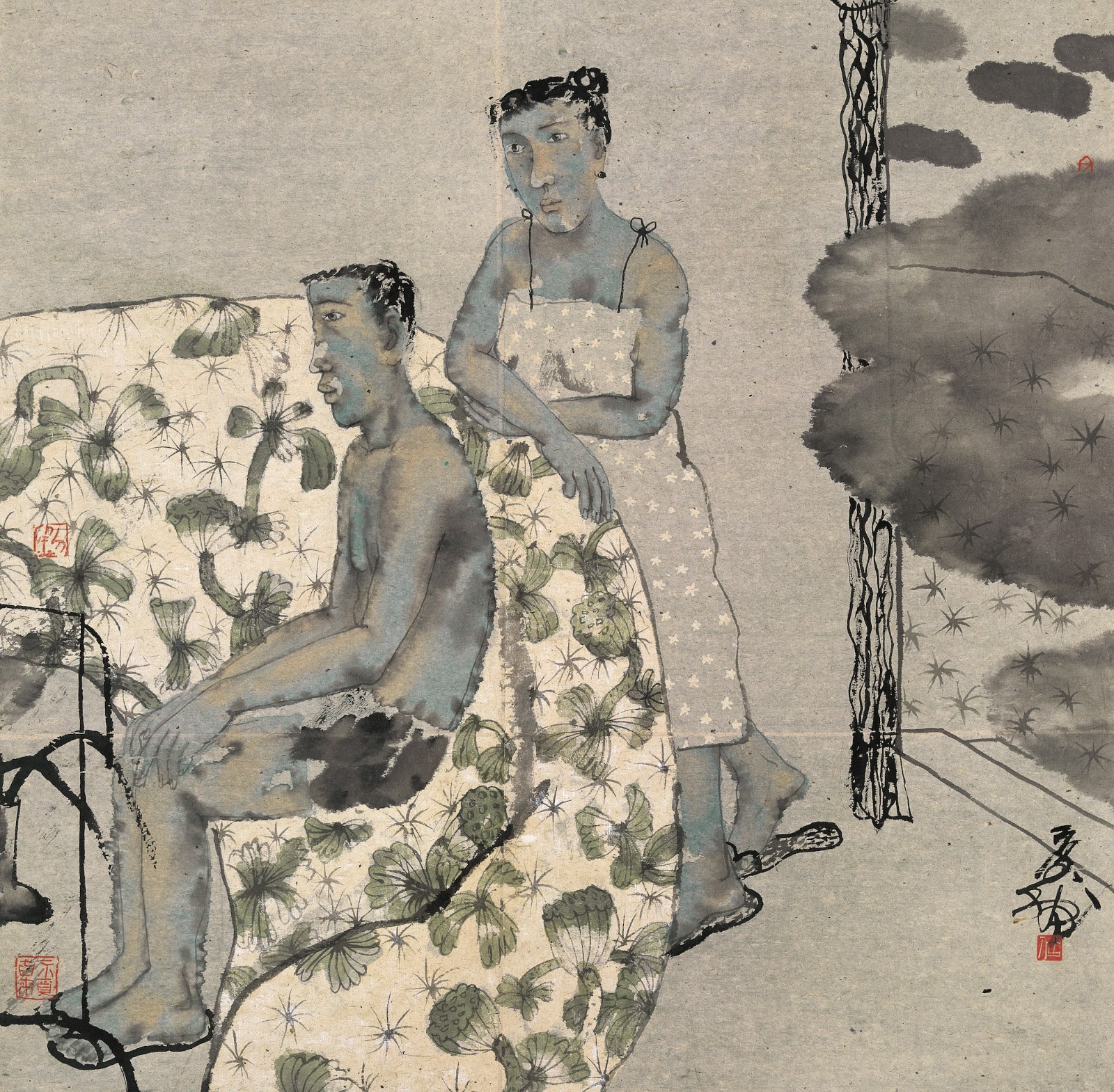 Saturday, Ink and wash on paper, 100 × 100 cm, 1992
Saturday, Ink and wash on paper, 100 × 100 cm, 1992
Historical Records: Old Portraits of Two Families
In 1961, Liu Qinghe was born in a place called Shen Zhuangzi in Tianjin. His grandfather amassed a fortune of 50 houses by operating the "Qingda Grain Warehouse." Tragedy struck early, with his grandfather's passing when Liu Qinghe's father was just seven. Only faded photographs whisper of his lost presence. Liberation ushered in a new era, and Liu Qinghe's father found himself a clerk at the "Chaoyang Cotton Shop." Officially, their family narrative morphed into "clerk and doctor," a stark contrast to their former wealth. These five souls, including siblings, formed a bygone family. Liu Qinghe's father remained a silent observer, stoically enduring life's injustices. His uncle, a stark counterpoint, was a vocal force, readily expressing his opinions. In that particular era, such candor often brought its tribulations. These contrasting figures, the stoic and the outspoken, became the family's guiding lights, representing two options for navigating life's currents. One leads to a "meaningless life," and the other to a "meaningful life." Thus, these portraits of the old family serve as Liu Qinghe's reflection on the past.
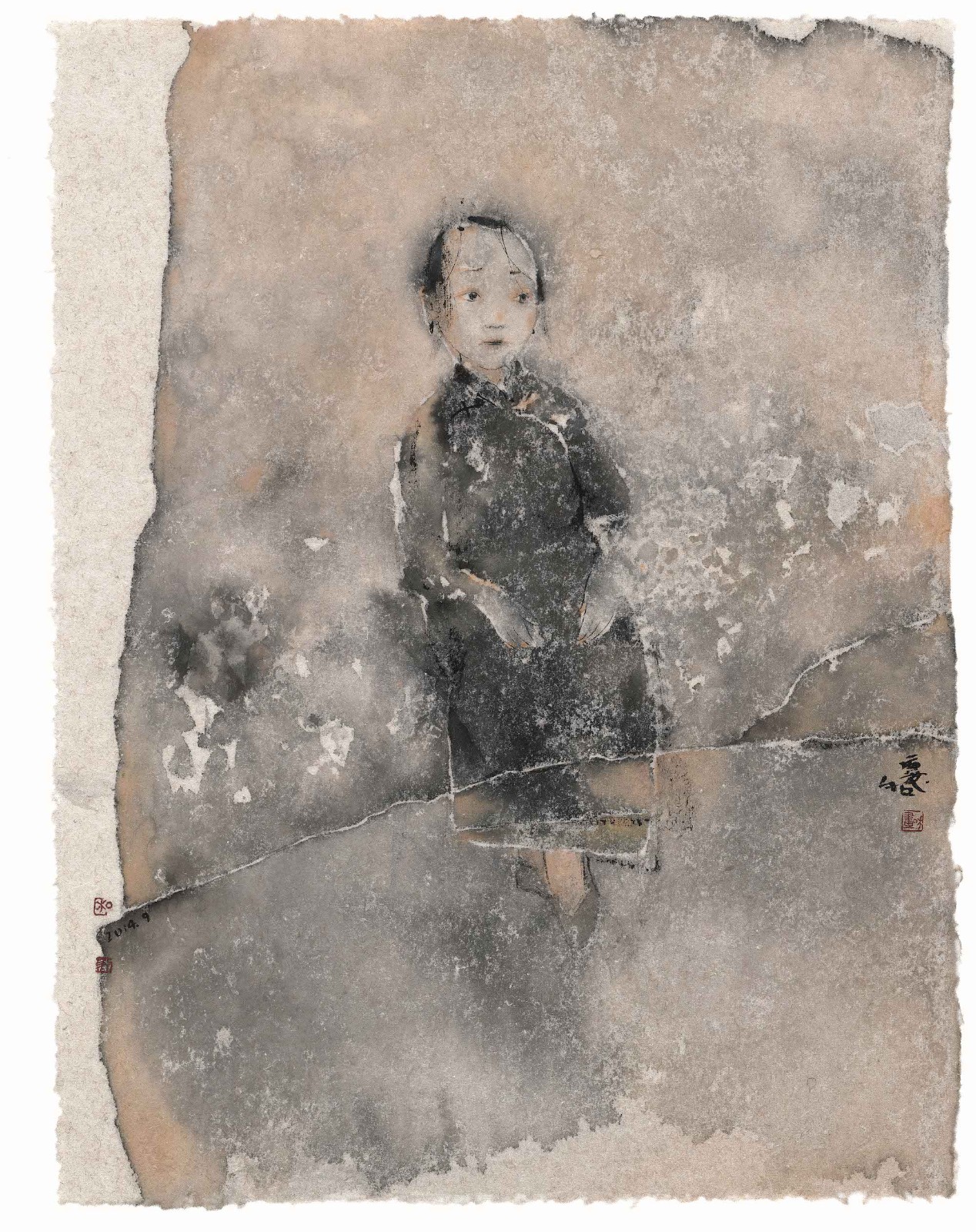
Auntie, Ink and wash on paper, 68 × 51?cm, 2014
Fast forward to the early 1990s, Liu Qinghe, who had graduated from the Central Academy of Fine Arts and stayed on as a faculty member, lived in the tube-shaped buildings in Wangfujing. The city, caught in a whirlwind of change, witnessed the academy's relocation to the then-"suburb", Wangjing. This relentless "urbanization" transformed both the city and Liu Qinghe's life at breakneck speed, mirroring the metamorphosis of countless Chinese families. Traditional gatherings, expressions of love, and the very furniture itself – all became brushstrokes in redefining the modern family. Confusion about life and the burdens of family gave way to the uncharted territories of "leisure time" and the rise of a burgeoning "middle class." It was during this period that Liu Qinghe participated in the groundbreaking "New Generation" exhibition. His works, meticulously detailed chronicles of his everyday life, captured the fleeting moments and unspoken emotions that formed the heart of the "family" unit.

Mom, Ink and wash on paper, 68 × 51 cm, 2014
In this sector, history unfolds not through grand pronouncements, but through the intimate chronicle of a single family. The seismic shifts within his family mirror the complex relationship between art and archives, history and information, and the individual and the collective. The figures in his paintings, their postures and expressions, reveal the changing times. So too do the styles of wedding photographs, the clothing, hairstyles, and even the gazes of the characters. He goes beyond the surface, including seemingly mundane objects – a water bottle, the reflection of age etched on a mirror. These details, bathed in the fleeting light and shadow, become testaments to the power and cruelty of time. They capture the human condition, a journey through the vast emptiness of time itself.
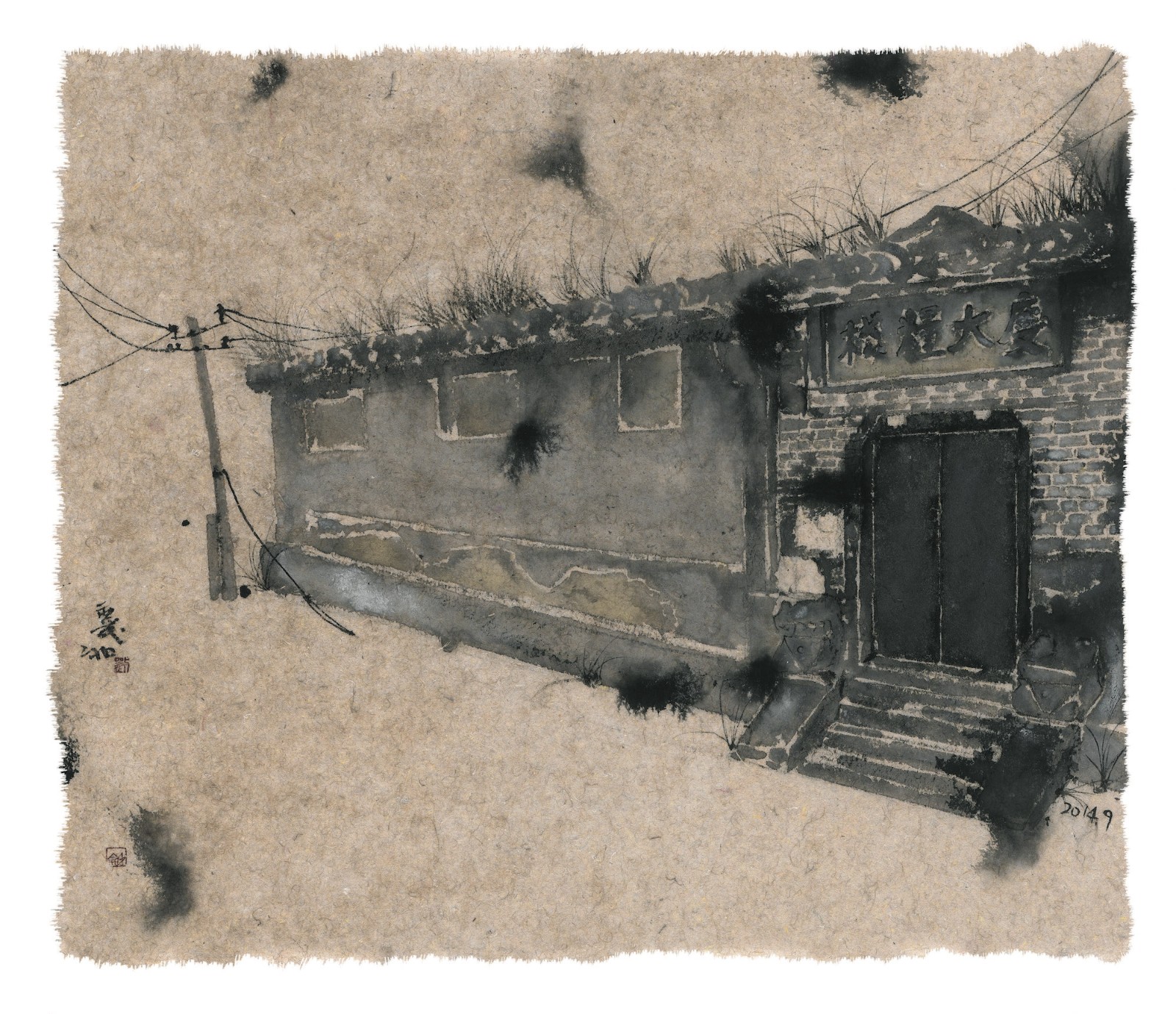
No. 18, Dongxin Street, Ink and wash on paper, 55 × 65 cm, 2014
Liu Qinghe's works transcend mere brushstrokes on canvas. Birthed from the crucible of time and memory, they transform into a personal archive. Each piece meticulously traces the labyrinthine paths of his memories, solidifying his own place within the grand narrative of his family. In doing so, they become inadvertent echoes of distant events, like whispers carried on the wind. These paintings stand as testaments to the seismic shifts that reshaped China over nearly a century – a microcosm that pulsates with the warmth of a bygone era.
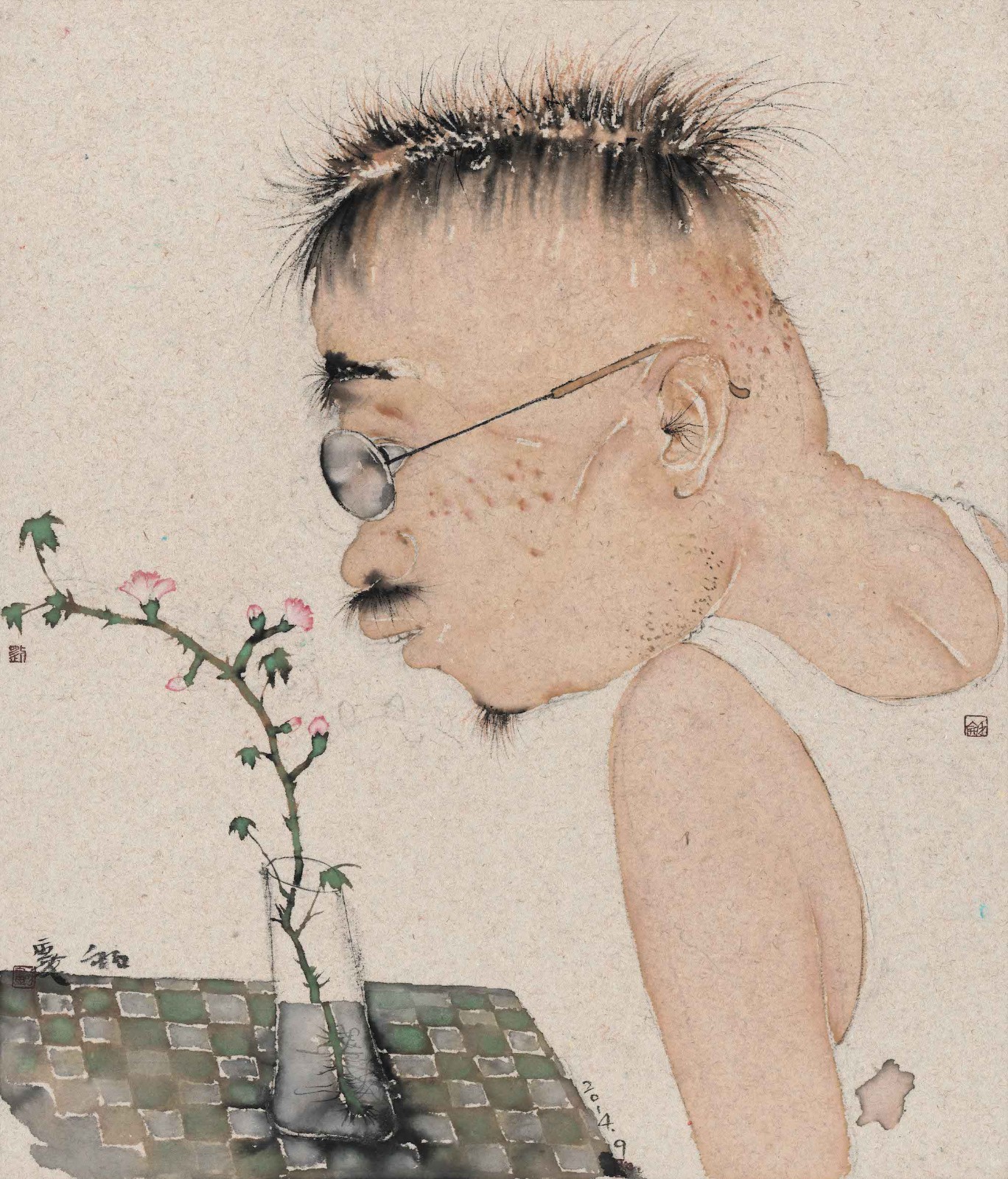
A Successful Year is Planned in the Spring, Ink and wash on paper, 65 × 55 cm, 2014
The Experimentation on Artistic Language
As artistic concepts evolve, so too does the language artists use to express them. This exhibition opens with a self-portrait by Liu Qinghe, depicting his own process of creation. It serves as a deliberate introduction – the artist, the narrator, welcoming us into his core exploration: how artistic language and structure can be manipulated to forge entirely new narratives.
Juxtaposed on the left side of the exhibition are portraits from different eras, inviting a comparative analysis. These life-sized works reveal a spectrum of forms and emotions elicited by variations in perspective and angle. The rendering of facial features differs, and the contrast between stark backgrounds and detailed ones, along with the depiction of hairstyles and postures, all emphasize the power of visual perception to shape our understanding. Across the room, a curated series unfolds the progression of Liu Qinghe's "storytelling." It begins with headshots, progresses to busts, and ultimately expands from individual figures to scenes bustling with multiple characters. This progression elegantly unveils his approach to narrative expression.
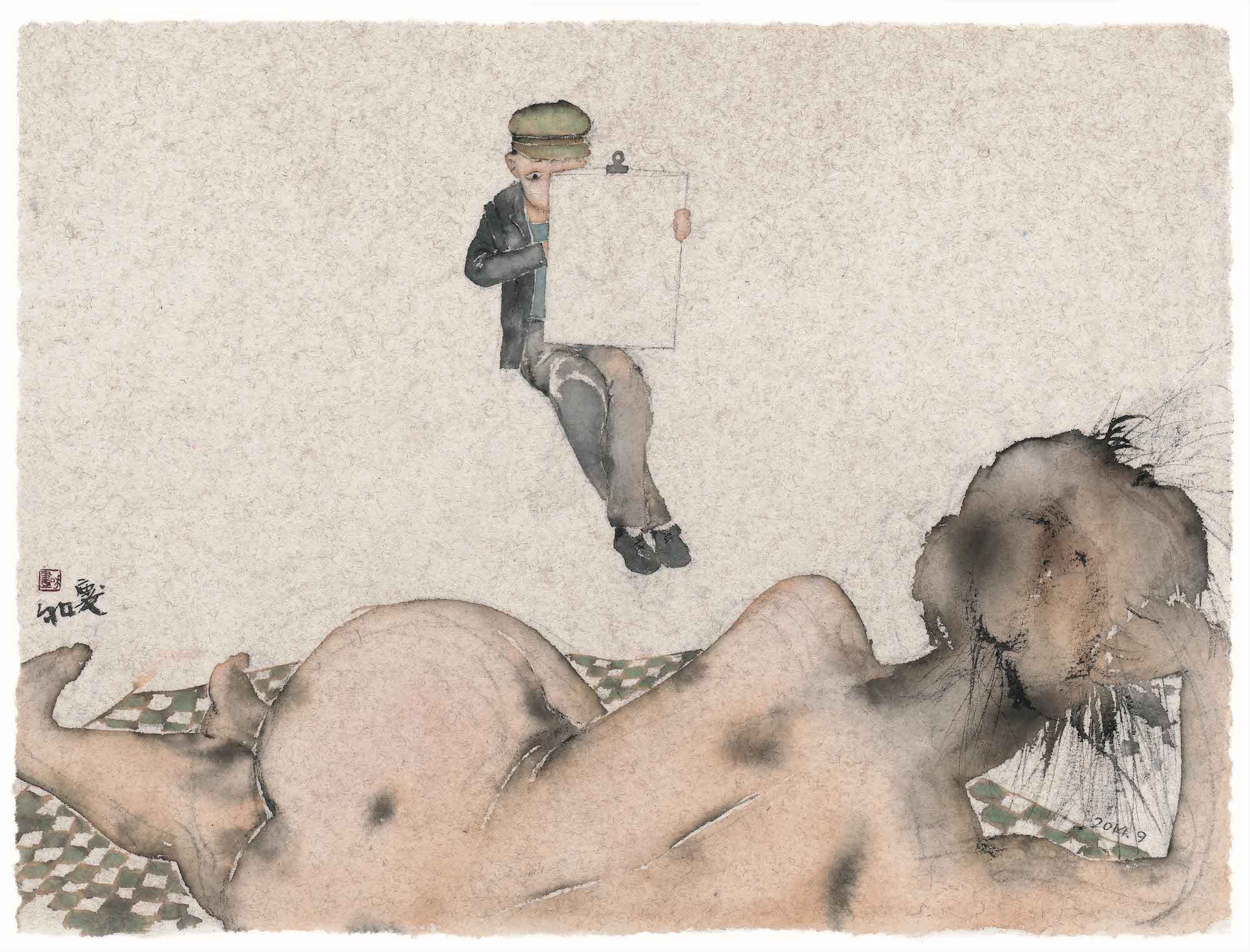 Drawing from Life, Ink and wash on paper, 51 × 68 cm, 2014
Drawing from Life, Ink and wash on paper, 51 × 68 cm, 2014
However, the centerpiece of the exhibition is the wall adorned with wooden panels. Here, we delve into the very essence of Liu Qinghe's artistic grammar. Throughout his career, he has fearlessly experimented with various media – sketching, line drawing, colored ink, painting, sculpture, photography, and installations. Liu Qinghe's artistic style is defined by his broad and diverse experiments across different media.
Experimentation is inherently risky. It embraces the possibility of "errors," requiring a constant spirit of exploration and the potential for failure. Consider this: Liu Qinghe could have comfortably settled into the role of a traditional ink artist, a path that would have garnered him recognition within that established field. Yet, his ambition soared beyond the confines of "ink" as a defining characteristic. He shed the protection it offered and embraced the vulnerability of forging his own path. The result? He has transcended the limitations of the avant-garde ink movement, persistently seeking richer artistic territories. Driven by an ambition rarely seen among ink artists, he strives to resonate with the ongoing transformations of contemporary art itself.

Baby Facing the Sun, Ink and wash on paper, 65 × 55 cm, 2013
Growth and Autobiography
In 1983, a pivotal moment in Liu Qinghe's artistic journey began at the Central Academy of Fine Arts. The entrance exam demanded not just artistic skill, but storytelling prowess. His challenge: create a six-panel comic script. He chose a subject close to home – the profound changes his uncle experienced during China's reform and opening-up. This was an early glimpse into Liu Qinghe's fascination with weaving personal narratives into his art.
Before Liu Qinghe, ink art rarely ventured into the realm of personal reflection. He pioneered a "semi-diary, semi-autobiographical, semi-spoken" approach, a stark contrast to the traditional styles of literati poetry or realism. His "Vernacular" series stands as a testament to this innovation. It challenged the established "grammar" of ink art, forging a new dialogue between concepts, media, narrative, imagery, and metaphor.

Hair Bristled with Anger, Ink and wash on paper, 67?× 51?cm, 2014
The series posed fundamental questions: how to tell stories effectively? How can visuals and text work together? Liu Qinghe's solution in "Vernacular" was a dual narrative: his own childhood and his daughter's growth. Inspired by postmodern cinema's multi-linear approach, he interweaves these stories separated by decades. Unresolved emotions from his memories, and the bittersweet warmth of childhood, all converge in his work. It becomes a "play within a play," a "screen within a screen," where past and present intertwine. These contrasting childhoods act as a powerful metaphor, reflecting not only personal growth but also the broader social and emotional shifts across generations. Through his art, Liu Qinghe occupies dual roles – son and father – experiencing the pains of growing up and the joy of nurturing.

Youth on the Banks of the Hai River, Ink and wash on paper, 65 × 55 cm, 2014
The "Vernacular" series lends a subtle yet captivating lens to memory. Through scattered documents, certificates, and textbooks, it invites viewers to glimpse an irretrievable childhood – its dormant secrets, its buried joys. The narrative itself recedes; what truly resonates is the unmatched tenderness Liu Qinghe evokes with his imagery and metaphors.
Another defining aspect of the "Vernacular" series is its regional flavor. Liu Qinghe's roots in Tianjin, a bustling port city, are evident. He skillfully incorporates the city's communicative spirit into his work, fostering a constant dialogue with the "other" – local versus urban, traditional versus modern, sequential art versus ink, ink versus contemporary art. In this process, the original properties of ink or individuals may change, but Liu Qinghe does not lose or deceive his own consciousness. He retains his unique accent and the characteristics of ink. Liu Qinghe's works are produced in this tension of difference.

Smoke-Cloud, Ink and wash on paper, 190 × 180 cm, 1993
New Urban, New Painting
The 1990s witnessed a societal transformation in China that is difficult to imagine today. Unprecedented change swept through the country at an astounding pace. A new term, "urban," entered people's consciousness for the first time, its influence permeating every aspect of life. This had a profound impact on people's understanding of their past lives, their desires, their sense of time, and their ideals.
The 1990s also marked the "adolescence" of Chinese urbanization. Like a teenager, this period was marked by restlessness, emotional instability, and a sense of confusion about reality. These powerful social shifts created a new landscape for artistic creation: cityscapes, leisurely afternoons, fleeting moments, and the dangerous yet intoxicating allure of nightlife.
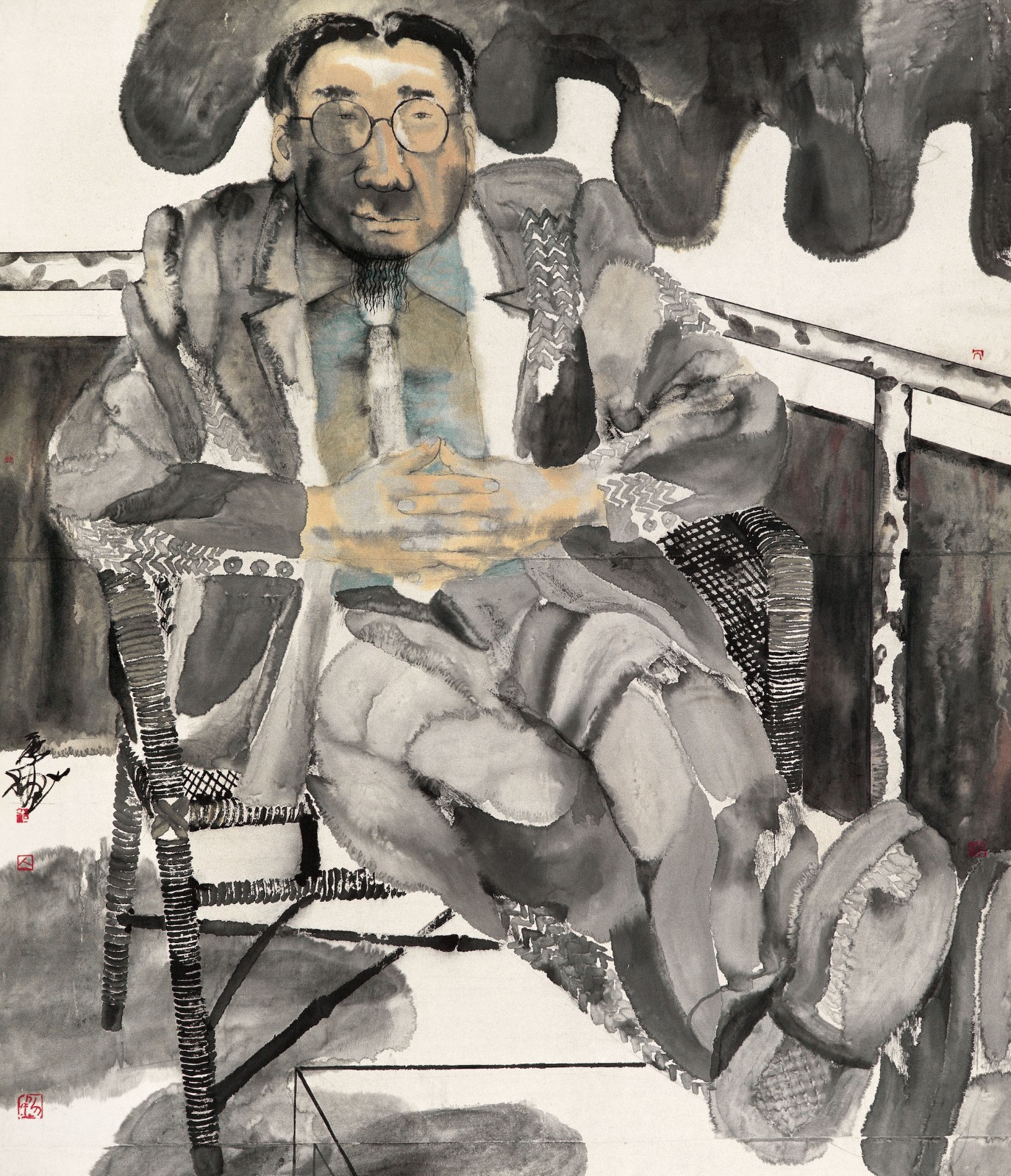
Mr. Wang, Ink and wash on paper, 140 ×120 cm, 1994
Riding the wave of China's rapid transformation in the 1990s, Liu Qinghe's artistic journey reached a pivotal point at the "New Generation" exhibition. Here, he unveiled his unique artistic vision and language, setting the stage for his most prolific and acclaimed period. His works from this era, such as "Smoke and Clouds" and "Mr. Wang," captured the zeitgeist of China's urban transformation, leaving an indelible mark on the history of art.
Liu Qinghe is a leading exponent of "urban ink," a style that seamlessly merges the essence of ink painting with the atmosphere of the modern city. His works possess the characteristics of both "urban" and "ink" forms, while also exhibiting unique and astonishing qualities. The inherent ambiguity and uncertainty of "water" and "ink," which are often seen as flaws in realistic painting, find new life in the context of urban scenes and situations. The hazy edges of Liu's works resonate with the visual experience of city life, while the limited palette of black, white, and subtle colors perfectly captures the essence of urban nightscapes. The "light and shadow" and "psychological landscapes" created through ink painting techniques perfectly align with the character of the modern city.

Breath, Ink and wash on paper, 180 × 140 cm, 2001
Unlike philosophical or sociological perspectives, Liu Qinghe's works expand the meaning of modern perception. They move beyond defining people through the lens of the modern city, focusing instead on depicting specific scenarios and situations. Through the ancient medium of ink, Liu harnesses its transformative power to capture the essence of this transformative era. Compared to the focus on character states in contemporary painting and photography of the same period, ink is better suited to expressing the scenes and sensations of urbanization itself. Liu Qinghe's works offer a visionary depiction of a unique "emotional current" specific to modern society.
Of even greater significance is the groundbreaking nature of Liu Qinghe's works, which demonstrate the transformative potential of ink as a medium. The unique sensations it provides accurately capture the urban illusion, fundamentally touching upon the "era sentiment" specific to that time. Together with Zhang Xiaogang's portrayal of large families, Fang Lijun's portrayal of cynical psychology, Yue Minjun's portrayal of laughing figures, and Mao Yan's portrayal of perplexed youth, Liu Qinghe's works collectively shaped the profound transformation of Chinese portraiture in that era.
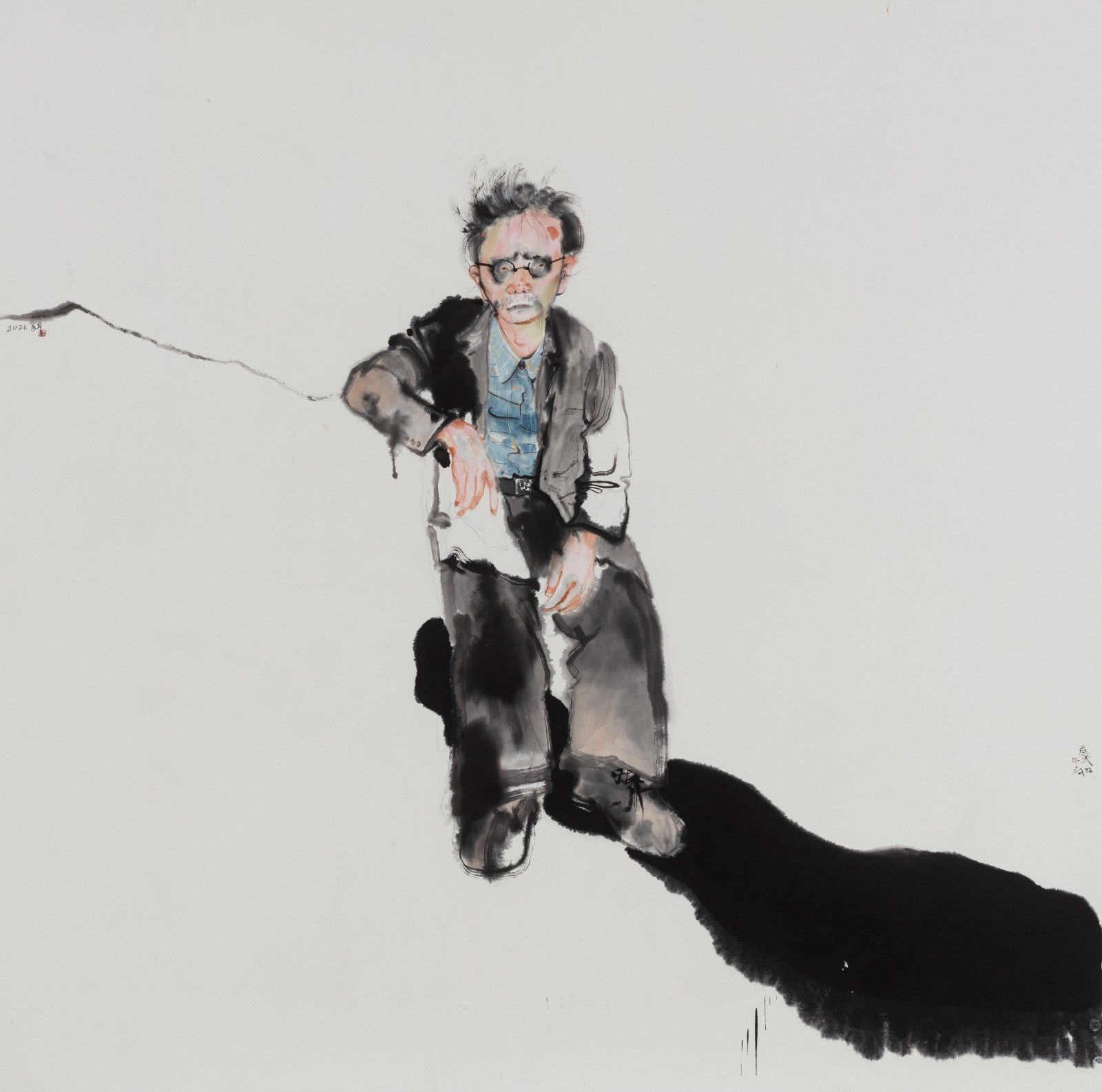
Setting Sun, Ink and wash on paper, 200 × 200 cm, 2021
Temporal Estrangement
A collection of small, intimate portraits on silk hangs on the left wall. A departure from his previous work, these pieces boast a clear, fashionable vibrancy with a translucent texture. While called sketches, their colors evoke the glow of a screen rather than natural light.
One portrait, featuring a stylish modern woman, particularly captures the eye. Instead of hard lines, flowing color defines her form, showcasing Liu Qinghe's keen grasp of both fashion and the evolution of artistic expression. Nearby, large-scale figures share the same ethereal luminescence, their colors vibrant yet fleeting. Unlike his past, sprawling panoramas, these works capture fleeting moments: a vanishing "point of light," a quick close-up, or just a tantalizing fragment. Created in the last three or four years, these paintings mark a new direction for Liu Qinghe. He's pivoted away from grand narratives of society and collective experiences, shifting his focus to individual modern figures. These characters, subtly connected to their era, yearn for a sense of self-isolation – a stark contrast to his earlier works that explored the shared human condition.

Black Dress, Ink and wash on paper, 200 × 200 cm, 2023
The notion of "practice makes perfect" rarely applies to Liu Qinghe's extensive artistic exploration. He consistently distances himself from familiar experiences, constantly seeking new possibilities to preserve a precious sense of "rawness" and "presence." Perhaps it is because he has never solidified into a singular "self" that his artistic style remains so diverse and ambiguous. His works are a tapestry woven from diverse threads: traditional ink sketches, the charm of literati painting, new light and shadow brought by technology, the leisure, simplicity, and elegance of women, the prevalent sense of alienation in modern society, and the imaginative magic and unfamiliarity, all intertwine repeatedly in his works.
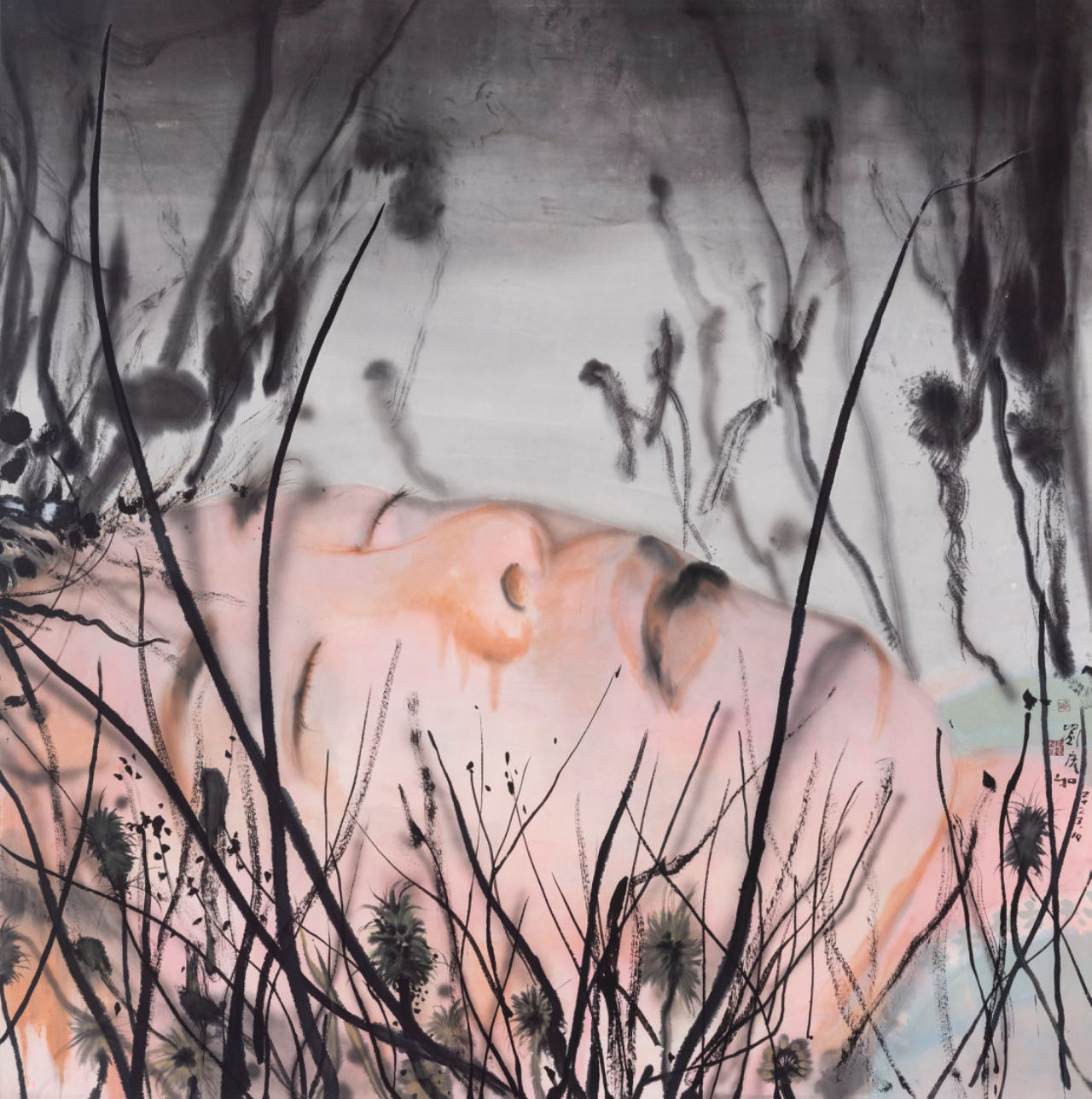
Shallow Water, Ink and wash on paper, 200 × 200 cm, 2023
"Temporal Estrangement" defines the immediate visual experience in this series. A product of the artist's relentless self-renewal, it alienates viewers from the familiar. It stems from the artist's handling of entirely new subjects and is derived from reality. Through each face, and each portrait, Liu Qinghe appears as a loyal observer and recorder of the era and trends. Yet, there is a subtle difference from reality; Liu leverages his experience to offer a fresh perspective, distilling a new kind of essence from reality. He extracts the emotional colors of the moment, those fleeting feelings swirling around us, and uses them to paint a picture that transcends simple observation. This is what elevates him from recorder to artist – his ability to capture the spirit of the age in a way that resonates on a deeper level.
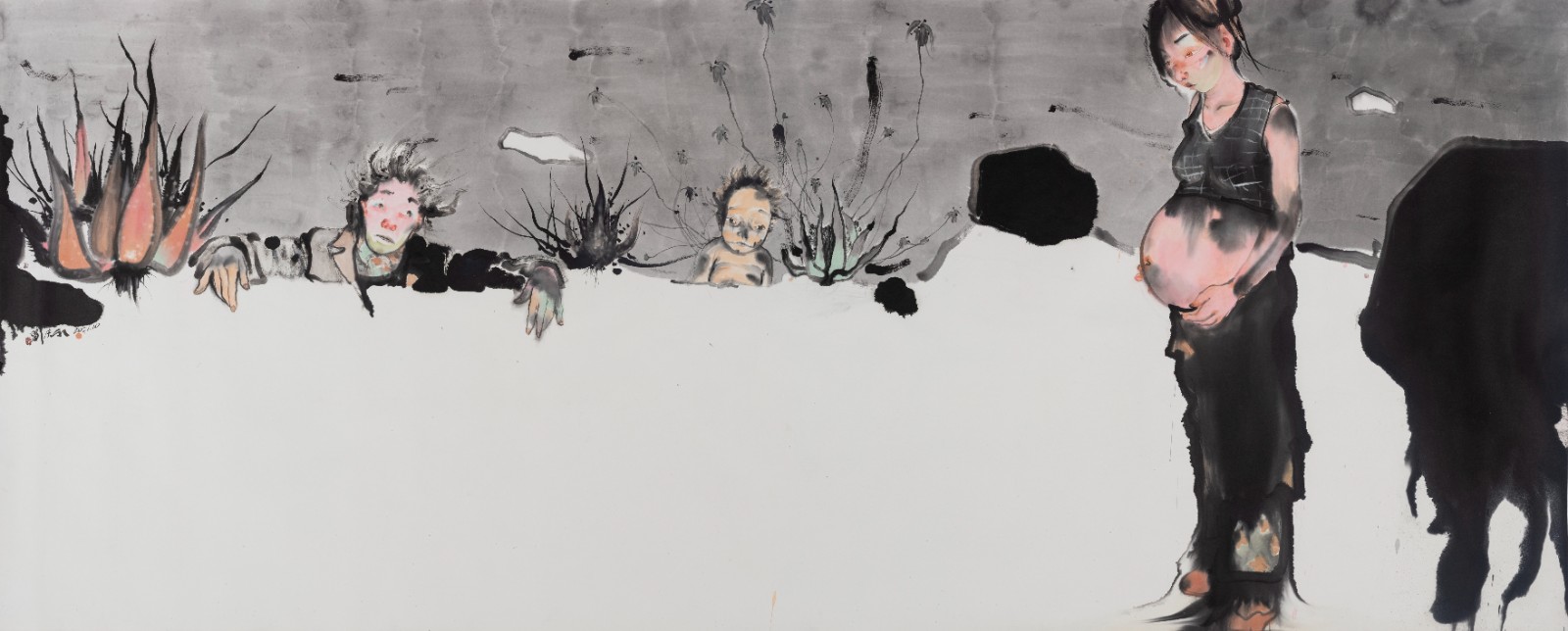
Love You, Ink and wash on paper, 200 × 500 cm, 2021
Looking Back: Recent Works
As the curtain falls on this exhibition, we present a final act – a selection of Liu Qinghe's newest works alongside glimpses from his artistic journey. We aim to trace the hidden threads that bind his worldview and philosophy of life over the past four decades.
Four vertical works, created in 2008, 2015, and 2023 respectively, form a unique series of contemporary landscapes by Liu Qinghe. Though labeled landscapes, these are not scenes ripped from reality. Rooted in tradition, they defy easy categorization. They neither embody the spiritual essence of Chinese literati painting nor the objective depiction of objects found in Western landscapes. Instead, they evoke a mysterious, unsettling terrain where ideals and theatricality intertwine. Like enigmatic rituals, their deeper meaning remains veiled. Perhaps we can venture to see them as dreamlike vistas, figments of the imagination existing solely within the mind's eye.

Meteor Shower, Ink and wash on paper, 220 × 170 cm, 1999
On the other side of the gallery hang two works that capture contrasting realities. "Meteor Shower" (1999) depicts a scene of urban dwellers gazing up at the night sky. Their faces are etched with perplexity, seeking solace in the vastness and unknowability of the universe, a stark contrast to the precarious figures clinging to a cliff face under the "Burning Sun" (2017). Here, everything feels suspended, a chilling reminder of life's precariousness. These contrasting images highlight the fundamental duality of existence. They evoke the constant dilemma between hope and despair, light and darkness, a struggle inherent in the human condition. A glimmer of hope appears in a new work titled "Love You." Here, the narrative begins at the very cradle of life, showcasing the complex tapestry of emotions that weave through our existence – pride and shame, innocence, and a hint of darkness. This new piece reminds us that life is a constant dance with crisis, offering no easy answers or clear pathways. Ultimately, we come to understand that everything, from the wild beauty of Liu Qinghe's sprawling landscapes and the relentless desires of the city to the dreams and growth of children in his "Vernacular" series, only represents fleeting moments without a destination. Our relentless pursuit of meaning in life and the emotions that color our existence may ultimately be exercises in futility.

Burning Sun, Ink and wash on paper, 300 × 150 cm, 2017
At first glance, these works might seem strangely devoid of logic or clear meaning. These depictions, often described as "empty," "poetic," and intensely psychological, defy easy categorization. Paradoxically, it's this very lack of readily apparent meaning that draws us in and reveals the true power of art. Liu Qinghe's art bypasses the limitations of conventional narratives and codified experiences. Instead, it taps into a deeper, more mysterious realm of human emotion and perception. The final work in the exhibition, a monumental canvas titled "Zero," perfectly embodies this concept of neutrality. It's neither passionate nor indifferent, a reflection of Liu Qinghe's introspective state as expressed in "Vernacular." He writes: "I wouldn't call myself a whole person. My movements are slow and disjointed, and my thoughts often wander. It's difficult for me to delve deeply into a single idea. I'm easily swayed by fleeting appearances, pulled off course onto paths that deviate from my original intent. This 'outdated approach' of combining painting with text description is a deliberate attempt to capture my current state of mind. It's a way of finding sustenance, of making sense of my own journey on life's smooth but often unpredictable path. Hoping to get validation from my old man didn't amount to much, as anticipated. What truly caught me off guard, though, is the realization that a purpose-driven and proactive life isn't significantly different from a seemingly purposeless life like my old man's. This revelation struck a chord with me."
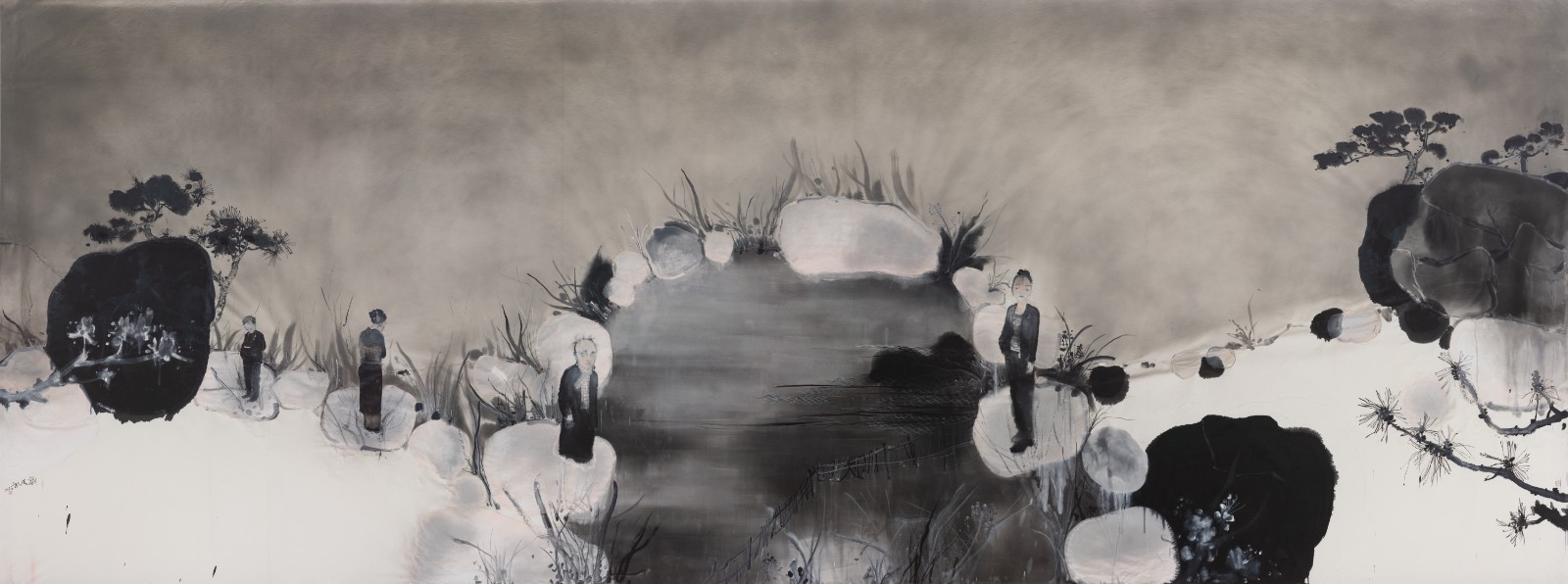
Zero, Ink and wash on paper, 306 × 800 cm, 2024
About the Artist

Liu Qinghe was born in 1961 in Tianjin. China. He received degrees from the Tianjin School of Arts and Crafts in 1981, and the Folk Art Department at the Central Academy of Fine Arts in 1987. he received his master’s degree from the Chinese Painting Department at the Central Academy of Fine Arts in 1989. He studied at the Academy of Fine Arts at the Complutense University of Madrid in 1992. He is currently a professor, graduate adviser of the School of Chinese Painting at the Central Academy of Fine Arts.
Liu Qinghe has held solo exhibitions at the National Art Museum of China, Minsheng Art Museum, Shanghai Museum, Power Station of Art, Powerlong Museum, Guangdong Art Museum, Xiangning Art Museum, Shenzhen Art Museum, Zhejiang Art Museum, Shandong Art Museum, Nanjing Museum, He Art Museum, Beijing Fine Art Academy Museum, Song Art Museum, Today Art Museum, Shenzhen Guan Shanyue Art Museum, the University Museum and Art Gallery at the University of Hong Kong. He has also participated in group shows at Grand Palais, Paris, France; Saatchi Museum, London; Museum of Modern Art, Hamburg Railway Station, Berlin; Goppingen Museum, Germany; Rijksmuseum Berlin, Germany; Chasson Museum, USA; MUMOK Museum of Modern Art, Vienna, Austria; Condduk Palace, Madrid, Spain; Debrecen Museum, Hungary; National Museum of Australia; Geelong Museum, Australia; Mexico Tamayo Museum of Modern Art, Curitiba Museum in Brazil, Fukuoka Asian Art Museum in Japan, Tokyo University of the Arts in Japan, National Gallery of Malaysia. He was named Ink Artist of the Year at the Eighth AAC Awards, and he won the Shanghai Securities News Annual Golden Artist Prize. L’Officiel Art named him Ink Artist of the Year in 2013. His work has been added to important private and institutional collections around the world.
About the Exhibition
Curator: Cui Cancan
Dates: 2024.3.9 - 2024.4.27
Venue: Tang Contemporary Art, Beijing 1st and 2nd Space
Courtesy of Tang Contemporary Art.


